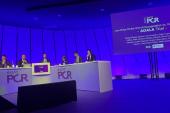Dropping Aspirin From Post-LAAO Regimens Seems Like a Good Idea
Registry data support less aggressive treatment postprocedure, but RCTs are needed for definitive answers, one expert says.

Using anticoagulation alone—and avoiding aspirin— appears to limit adverse events after left atrial appendage occlusion (LAAO) with the Watchman FLX device (Boston Scientific), an analysis of real-world data suggests.
The overall rate of major adverse events at 45 days and 6 months was lower among patients discharged on a direct oral anticoagulant (DOAC) alone compared with those who received a DOAC plus aspirin, driven by a significantly lower rate of major bleeding, according to lead author Samuel Reinhardt, MD (Yale University School of Medicine, New Haven, CT), and colleagues.
Forgoing aspirin did not come at the cost of more thromboembolic events or device-related thrombus, they report in a study published online ahead of the September 3, 2024, issue of the Journal of the American College of Cardiology.
Senior author James Freeman, MD (Yale University School of Medicine), told TCTMD that the findings are consistent with an earlier study he led examining the impact of different antithrombotic strategies following LAAO with the first-generation Watchman device.
Together, the two studies show “that the aspirin really doesn't add anything in terms of preventing thrombotic events and it substantially increases the risk for bleeding,” Freeman said. “So that's really our main take-home here, and the thing we care about most is trying to get practice to move away from adding aspirin to DOAC in the postprocedural period.”
Lorenz Räber, MD PhD (Bern University Hospital, Switzerland), who was not involved in the new analysis, said that makes sense because most patients who undergo LAAO have a prior history of bleeding and would thus be at greater risk for additional bleeding with more intensive antithrombotic therapy.
He added, however, that additional research will be needed to support any changes to practice recommendations. “To me as an operator, it reassures me that I'm on the right path if I give only DOAC alone, but as usual, to change the guidelines, RCTs are needed,” Räber said.
Lower Risk of Major Bleeding
LAAO has emerged as an option for stroke prevention in patients with atrial fibrillation who have a reason to avoid long-term anticoagulation. Initially, the standard antithrombotic regimen after the procedure—based on what was used in the pivotal Watchman trials—was warfarin plus aspirin for 45 days, followed by dual antiplatelet therapy (DAPT) up to the 6-month mark and aspirin thereafter.
Real-world practice has varied, however, with DOACs being introduced as an anticoagulant option and a mix of antiplatelet options coming into play. Moreover, the next-generation Watchman device was approved based on the findings of the PINNACLE FLX trial, in which patients received a DOAC plus aspirin at discharge. That regimen is an accepted alternative to warfarin plus aspirin on the device’s label; DAPT was subsequently added, too.
To explore which antithrombotic regimens are being used in everyday practice and tease out any differential effects, Reinhardt, Freeman, and colleagues turned to SURPASS, a subregistry of the LAAO Registry that is part of the American College of Cardiology’s National Cardiovascular Data Registry. The analysis included 53,878 patients (mean age 76 years; 41% women) who underwent successful LAAO with the Watchman FLX between August 5, 2020, and December 31, 2021.
The most common antithrombotic regimen administered at discharge was a DOAC plus aspirin (48.3%), followed by a DOAC alone (22.6%), DAPT (8.1%), warfarin plus aspirin (7.7%), and a DOAC plus a P2Y12 inhibitor (4.9%).
For the various regimens, the investigators assessed the risk of major adverse events, which included all-cause death, stroke, TIA, intracranial hemorrhage, major bleeding, systemic embolism, major vascular complications, MI, pericardial effusion requiring surgical or percutaneous intervention, cardiac arrest, and device embolization.
On multivariate analysis, a DOAC alone was associated with lower rates of major adverse events (2.4% vs 3.7%; adjusted HR 0.78; 95% CI 0.68-0.91) and major bleeding (1.5% vs 2.7%; adjusted HR 0.69; 95% CI 0.60-0.80) at 45 days compared with a DOAC plus aspirin. These differences persisted at 6 months.
Warfarin alone (used in only 2.4% of patients) also carried a lower risk of major bleeding, but with no difference in overall major adverse events.
In general, choice of antithrombotic regimen didn’t influence the risk of thromboembolic events, death, or device-related thrombus, although DAPT was associated with a higher rate of stroke/TIA at 45 days when compared with a DOAC plus aspirin (0.5% vs 0.3%; HR 1.71; 95% CI 1.13-2.59). That finding was consistent at 6 months.
But both Freeman and Räber cautioned against reading too much into that result, pointing to the higher baseline risk of bleeding observed in patients who received DAPT.
Of note, DAPT is recommended as the postprocedural regimen after use of the Amplatzer Amulet LAAO device (Abbott), which was approved by the US Food and Drug Administration in 2021.
“The fact that both the Amulet IDE trial and our analysis showed no increase in adverse events among patients on DAPT suggests that it may be a reasonable alternative for patients who are deemed to be higher risk for bleeding with anticoagulation,” the study authors write. “Given the potential confounding of DAPT being used primarily in sicker patients at higher bleeding risk in real-world practice, we believe that a randomized controlled trial comparing DOAC versus DAPT in patients after LAAO is necessary to determine which regimen results in better outcomes. A trial of this nature is currently in development.”
Some Caveats
Although this study supports the idea that being less aggressive with post-LAAO antithrombotic therapy will reduce bleeding without increasing thromboembolic events, there are some limitations, Räber said.
As an observational study, it is subject to residual confounding, he said. In addition, he said, the recorded rates of events like stroke, device-related thrombus, and pericardial tamponade were unrealistically low, suggesting underreporting.
“And of course this needs to be taken into account when interpreting the results,” Räber said, underscoring the need for an RCT to provide a more conclusive answer in this data-free zone. “There are only a few RCTs, and they were all underpowered.”
Also, further research is needed to explore antithrombotic regimens that were not well represented in this analysis, including single antiplatelet therapy and reduced-dose DOACs, he said, noting that the ADALA trial has indicated that low-dose DOAC may be enough after LAAO.
“The future direction clearly is going towards a less aggressive treatment regimen because these patients are bleeding patients,” Räber said. “These patients come to you because they bleed and then letting them discharge with an intense antithrombotic or antiplatelet treatment regimen really, really is not a good idea.”
The study authors acknowledge several limitations of their analysis, but Freeman said these findings are strengthened by the similarity in baseline patient characteristics across the treatment groups (apart from the higher bleeding risk seen in the DAPT-treated patients).
He added that he hopes these data will be sufficient to add DOAC monotherapy as a post-LAAO treatment option on the Watchman FLX label. “I think we’ve clearly demonstrated that there's absolutely no harm to getting rid of the aspirin. And I think we've demonstrated that adding the aspirin has really only increased the risk for bleeding,” said Freeman.
Todd Neale is the Associate News Editor for TCTMD and a Senior Medical Journalist. He got his start in journalism at …
Read Full BioSources
Reinhardt SW, Gibson DN, Hsu JC, et al. Anticoagulation alone vs anticoagulation plus aspirin or DAPT following left atrial appendage occlusion. JACC. 2024;84:889-900.
Disclosures
- The analysis was supported by Boston Scientific.
- Freeman reports having received research funding from the National Institutes of Health/National Heart, Lung, and Blood Institute, and the American College of Cardiology National Cardiovascular Data Registry; having received consulting/advisory board fees from Medtronic, Boston Scientific, Biosense Webster, and PaceMate; and having equity in PaceMate.
- Räber reports research grants to his institution and speaker/consulting fees from Abbott and Boston Scientific.
- Reinhardt reports no relevant conflicts of interest.






Comments